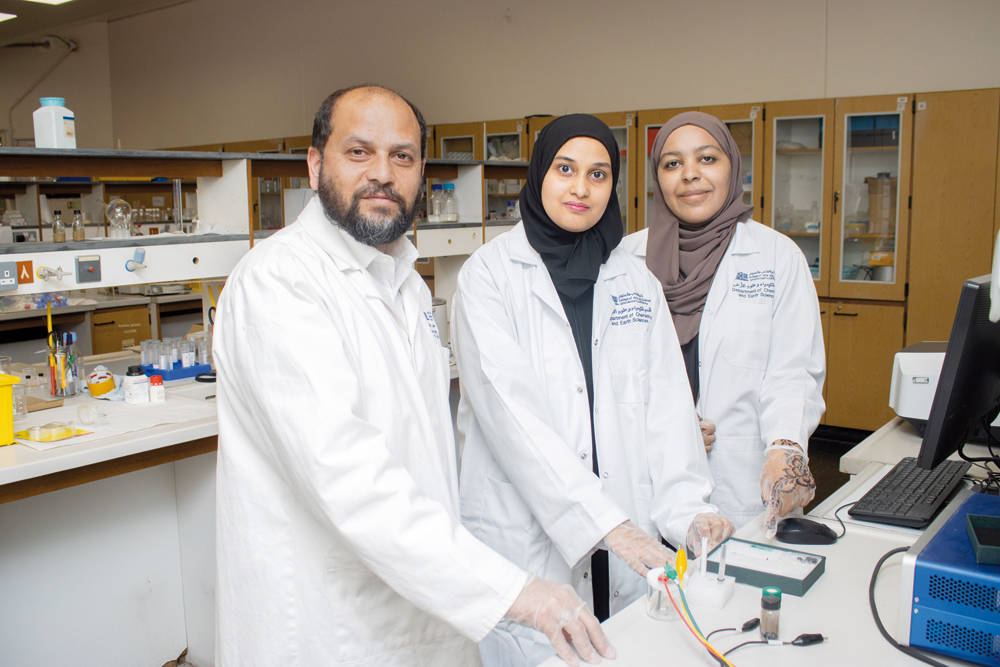Maimoona Mohamed and Nada Yahya Deyab, undergraduates at Qatar University’s Department of Chemistry and Earth Sciences, together with their supervisor Dr. Shabi Abbas Zaidi, Associate Professor of Analytical Chemistry, have made significant progress on the difficult problem of oil-water separation.

Their research focuses on developing a new material for the efficient separation of oil from oil-water mixtures. By using reduced graphene oxide (rGO) to modify polyurethane (PU) sponge and cotton, they have achieved promising results in terms of hydrophobicity, oil-absorbing efficacy, reusability, and cost-effectiveness. Water pollution and soil pollution problems offer a promising solution.
The harmful impact of oil spills on the environment due to transportation, household use and industrial activities has long been in the spotlight.
The scientific community has been actively seeking efficient ways to recover and separate oil from water, and a team at Qatar University has made significant progress in this regard.
The three-dimensional porous structure of polyurethane sponge shows promise in oil-water separation. However, poor hydrophobicity limits its oil absorption efficiency. To overcome this limitation, the research team focused on enhancing the hydrophobicity of the sponge by tuning it with graphene oxide (GO), which was subsequently reduced to reduced graphene oxide (GO) using the readily available green reducing agent L-ascorbic acid (L-AA). rGO).
Graphene oxide (GO) was synthesized by mixing 1 g of graphite flakes with 23 mL of 98% sulfuric acid and stirring at room temperature for 24 hours. Subsequently, 100 mg of sodium nitrate was added, and the mixture was stirred for 30 minutes.
Subsequently, 3 g of potassium permanganate was gradually added, and the resulting mixture was heated and stirred for about 30 minutes.
Water was further added, followed by 10 ml of 30% hydrogen peroxide to complete the synthesis. The resulting graphene oxide (GO) was then centrifuged to remove unoxidized graphite and dried to obtain a powdery substance. The synthesized monolithic graphene oxide (GO) was dispersed in distilled water for reduction and modification studies.
To create the rGO-PU sponge, the research team adopted a green method utilizing L-ascorbic acid as a reducing agent. First cut the polyurethane sponge into small pieces and rinse thoroughly with distilled water and acetone before drying. Graphene oxide (GO) aqueous dispersion was prepared by sonication, and L-ascorbic acid was dissolved in it. A dry polyurethane sponge was dipped into this mixture and left under gentle agitation for 48 hours.
Then, the sponges were washed and dried to obtain rGO-PU sponges. rGO-cotton can also be obtained by the same method. Compared with the unmodified sponge, the modified surfaces of rGO-PU and rGO-cotton both exhibited excellent absorbency and water contact angle.
The excellent performance of the rGO-PU sponge was verified by absorbing and collecting oil in the oil-water mixture, with a recovery rate as high as 97%.
Furthermore, the rGO-PU sponge exhibited excellent reusability and compressibility without any signs of cracking or leakage. In a comparative study, the team found that rGO-PU sponge was highly compressible and porous than rGO cotton in various samples.



 微信扫一扫打赏
微信扫一扫打赏
